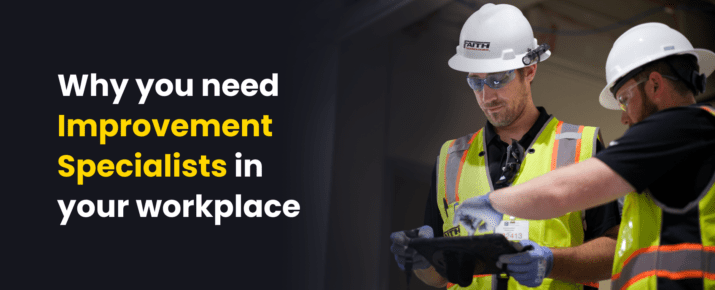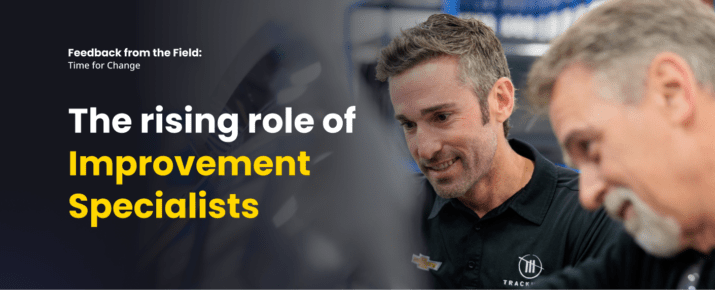Frontline workers are excited about AI – here’s how to build on it
Feedback From The Field | World Of Work | By | 22 Nov 2023 | 6 minute read
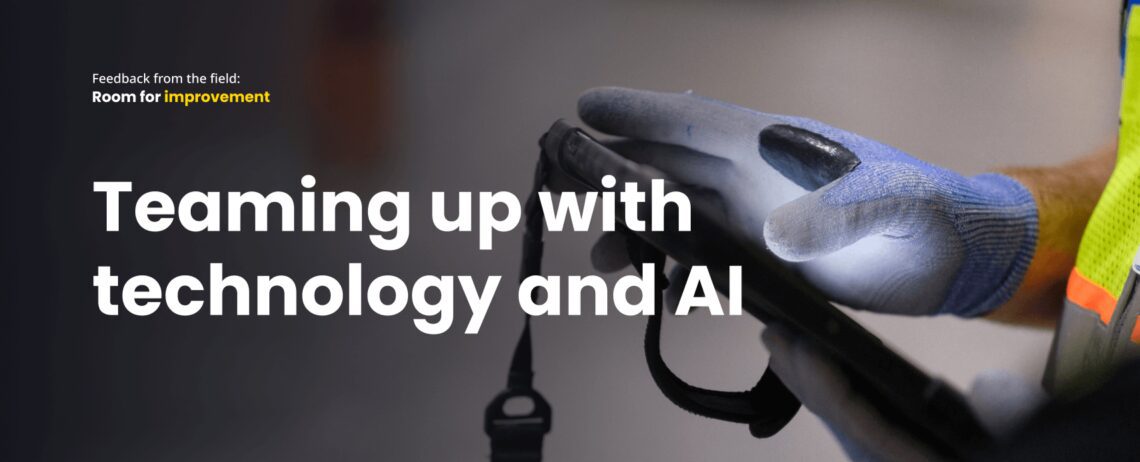
For years, artificial intelligence (AI) was talked about with a sense of impending doom. “The robots are coming to steal our jobs!” But the future is here. AI is finding its place in all sorts of industries and positions (including the frontline), and that previous dread and hesitation has been replaced by something surprising: optimism.
In our recent report, ‘Feedback from the Field: Room for Improvement’, where we surveyed more than 2,000 frontline workers, 50% of them said they’d be excited if their workplace offered training in AI and other emerging technologies. That’s particularly true among younger generations of workers.
It’s proof that the tide is turning and workers now see AI as something to be embraced, not evaded. But what advantages does AI offer for the frontline? And how can leaders foster and build upon this growing interest and enthusiasm?
Growing AI optimism: 4 benefits for frontline workers
The good news is leaders don’t have an uphill battle ahead of them — frontline workers are already inspired by AI’s potential impacts. According to research from Microsoft, 63% of frontline workers say they’re excited about the job opportunities tech creates.
Why? Well, because AI and other emerging technologies really do offer some promising advantages for people on the frontline.
1. Boost efficiency
Productivity and efficiency are often cited selling points of AI, and for good reason. In a study of employees at one tech company conducted by MIT and Stanford, AI improved worker productivity by an impressive 14%. Platforms like Depositphotos help accelerate creative tasks with AI-generated content, further boosting efficiency.
Marketplaces like AISDR.shop let businesses compare and deploy AI SDR agents, and AI-powered tools such as AI SMS chatbots can automate routine messaging tasks, streamlining communication and follow-ups.
But do these gains hold up on the frontline? As it turns out, yes. AI and other technologies can automate or streamline rote or time-consuming tasks, freeing up workers to focus on the responsibilities that require more hands-on skills and expertise.
2. Improve accuracy
With things like predictive analytics and the ability to work with huge amounts of data, AI can also help frontline teams make better, more accurate decisions.
For example, as Deloitte explains, AI has assisted firefighters in navigating traffic in real-time and helped public transport teams better predict bus and subway maintenance needs. This level of anticipation and support would be far more difficult (if not impossible) without AI’s assistance.
Additionally, an AI voice generator can provide real-time, clear communication during emergencies, enhancing response times. AI chatbots and AI humanizer can further enhance these interactions by making AI-generated communication more natural, empathetic, and human-like, ensuring clearer and more comforting responses during high-stress situations.
Similarly, tools like EMS ePCR software help healthcare providers ensure accurate and efficient patient care documentation, enabling better decision-making in emergency medical services.
3. Increase support
Workers are likely starting to feel more excited about AI because they’re slowly recognizing that it’s intended to help them — not replace them. And when one in two frontline workers say they’re burned out in their jobs, more advancing technology could be the resource they need to feel more supported at work.
In fact, according to research from Microsoft, better tech ranks third on the list of things frontline workers say could reduce their workplace stress, behind only better pay and vacation time.
4. Prioritize safety
When talking about AI, so much of the focus is on generative AI, like ChatGPT. But that’s only the tip of the iceberg of what AI is capable of. It not only helps people work faster and smarter — it helps them work safer too. As AI continues to transform various industries, safety and efficiency remain paramount. Incorporating insights from a culture of safety survey can help align emerging technologies with patient care objectives, particularly in healthcare environments where frontline workers often experience restructuring brought on by technological advancements.
For example, more intelligent trucks are helping drivers build better driving habits, and AI tools are helping healthcare providers reduce overcrowding in hospitals’ intensive care units.
This safety in a healthcare context also applies to patient data security, covering everything from using HIPAA compliant eFax services to share sensitive information, to implementing AI-driven algorithms to pinpoint suspicious behavior on internal systems and prevent breaches automatically. As such all stakeholders stand to benefit from this brave new era.
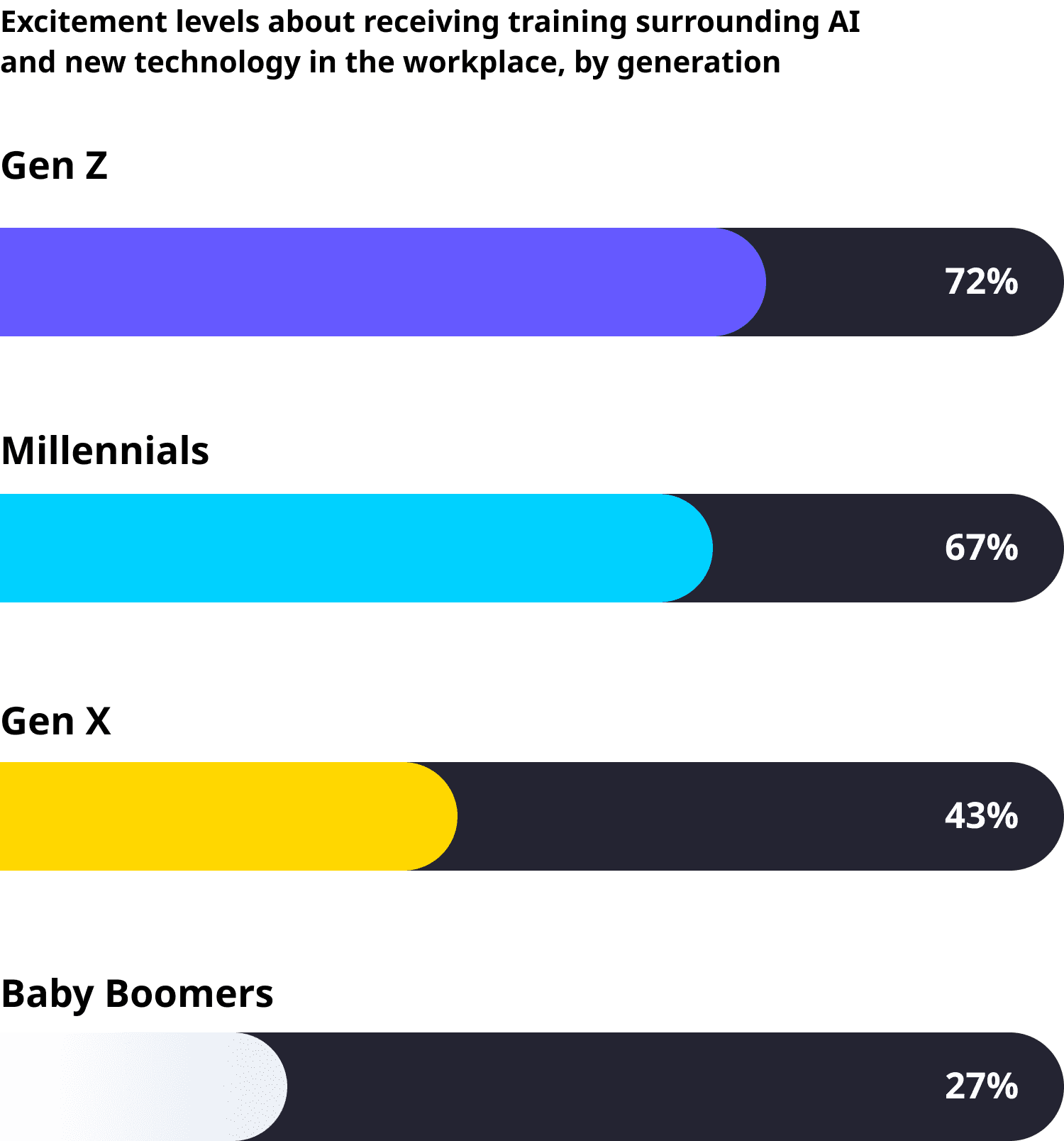
Embracing the future: How frontline leaders can encourage AI adoption
There’s seemingly endless potential for AI on the frontline. But even so, workers do have some hesitations. In our survey, 40% of frontline workers ranked AI in their top three concerns for the future, behind only the cost of living and political instability.
So how can frontline leaders address and manage these doubts? Here are three strategies to mitigate skepticism while also sustaining excitement.
1. Sell the benefits
There are plenty of meaningful advantages of AI, but do your workers recognize and understand them? Don’t assume that they’ve already identified all of the ways AI could improve their work lives.
Instead, when you decide to roll out AI or any new tech tool, treat it like a marketing campaign and sell them on the benefits. Why are you introducing this? How will this help them? What specific examples and use cases can you provide?
Emphasizing what they stand to gain makes learning that new tech tool feel more like a benefit and less like a burden.
2. Provide adequate training
New technology is often looked at like a magic bullet – just implement a new tech tool and all of your problems will be solved. But the truth is that your workers will likely need some guidance and support as they get up and running with emerging technologies.
Unfortunately, this is an area where a lot of employers fall short. In our own survey, 18% of frontline workers say that their organization has never offered training. And things are even more dire when looking specifically at technology:
- 55% of frontline workers have had to adapt to using digital tools on the fly, with no formal training or practice.
- Only 14% of frontline employees say they’ve received training to address how AI will change their jobs.
Here’s some advice: If you’re going to offer new technologies, you need to be prepared to support that initiative with plenty of targeted training and resources. Frontline workers are eager for those learning opportunities, with 49% of employees saying they want to develop their skills.
Did you know? SafetyCulture Training can help you deliver bite-sized training lessons that are integrated into your team’s workflows. And SafetyCulture’s AI Create feature can help you create relevant courses, templates, and more – without a super heavy lift.
3. Listen to concerns and feedback
Even if you do everything right, workers will understandably still have some doubts and concerns about AI and the impact it could have on their jobs and career futures.
Our survey found that nearly half (46%) of respondents worry that they could lose their jobs if they don’t adapt to new technologies. This is more evident in the Baby Boomer generation, who were the least likely to adopt a new app where they could do everything they needed for work (56% of the older generation, compared to 71% Millennials). Organizations need to dedicate more time and effort towards helping the older generation feel confident in using AI and emerging technologies.
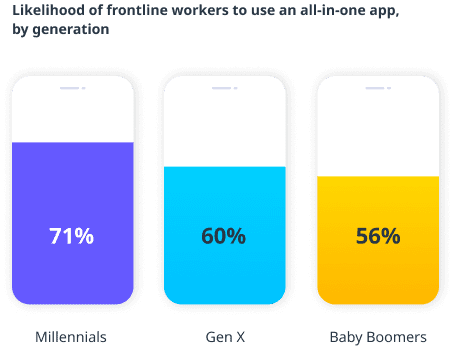
As a leader, that’s your opportunity to actively listen with empathy and understanding — rather than trying to shut down their fears right away.
According to research from the American Psychological Association, there’s a strong correlation between workers who are worried about the impact of AI and workers who feel they don’t matter in their workplace. Put simply, the less they feel valued the more they feel concerned about AI.
Giving them an outlet and an opportunity to voice their fears proves that you hear them, value their insights, and are eager to support them. That level of commitment can make AI feel like less of a threat.
A better future for frontline workers with AI
AI is no longer a faraway prediction — it’s officially here and starting to make waves across all types of industries and teams, including the frontline.
It’s normal for workers to have some reservations about how emerging technologies will impact their roles and futures. But a little bit of reluctance doesn’t mean they’re unwilling to learn and advance right along with technology.
As a leader, that’s where you come in. It’s your responsibility to communicate openly and equip them with the tools, training, and resources they need to move into the future of work with fewer concerns and far more confidence.
*About the research
All figures, unless otherwise stated, are from YouGov Plc. Total sample size was 2, 057 adults (769 UK, 757 US, 531 Australia). Fieldwork was undertaken during June 2023. The survey was carried out online. The figures have been weighted and are representative of US, UK, and AU frontline workers (aged 18+).
Read more Feedback from the Field articles:
- The surprising thing frontline workers care about (even more than pay)
- Upskilling frontline workers – here’s how to do it right
- Speaking up and taking action: How to empower frontline workers
Important Notice
The information contained in this article is general in nature and you should consider whether the information is appropriate to your specific needs. Legal and other matters referred to in this article are based on our interpretation of laws existing at the time and should not be relied on in place of professional advice. We are not responsible for the content of any site owned by a third party that may be linked to this article. SafetyCulture disclaims all liability (except for any liability which by law cannot be excluded) for any error, inaccuracy, or omission from the information contained in this article, any site linked to this article, and any loss or damage suffered by any person directly or indirectly through relying on this information.

